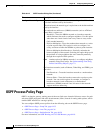
64-42
User Guide for Cisco Security Manager 4.4
OL-28826-01
Chapter 64 Configuring Routing Policies
RIP Routing on Cisco IOS Routers
RIP Routing on Cisco IOS Routers
Routing Information Protocol (RIP) is an Interior Gateway Protocol (IGP) that was created for use in
small, homogeneous networks. RIP is a distance-vector protocol that sends routing-update messages at
regular intervals (in a process called advertising) and whenever the network topology changes. When a
router receives a routing update that includes changes to an entry, it updates its routing table to reflect
the new route. If a router does not receive an update from another router for 180 seconds or more, it
marks the routes served by the non-updating router as being unusable. If there is still no update after 240
seconds, the router removes all routing table entries for the non-updating router. Routing information is
exchanged using UDP packets.
RIP evaluates routes by measuring the number of hops (the number of routers traversed) from the source
to the destination. A directly connected network has a metric of zero. The maximum hop count allowed
by RIP is 15. Any route with a hop count greater than 15 is considered unreachable.
Security Manager supports RIP version 2 only, which is described in RFC 1723. RIP 2 improves on the
original RIP by enabling RIP messages to carry more information, which permits the use of a simple
authentication mechanism (clear text or MD5) to secure table updates. RIP 2 also supports subnet masks,
a critical feature that was not available in the original version of RIP.
The following topics describe the tasks you perform to create a RIP routing policy:
• Defining RIP Setup Parameters, page 64-42
• Defining RIP Interface Authentication Settings, page 64-43
• Redistributing Routes into RIP, page 64-44
Related Topics
• Static Routing on Cisco IOS Routers, page 64-50
• OSPF Routing on Cisco IOS Routers, page 64-19
• EIGRP Routing on Cisco IOS Routers, page 64-8
• BGP Routing on Cisco IOS Routers, page 64-1
Defining RIP Setup Parameters
You configure RIP setup parameters by selecting the networks to include in the route and deciding
whether any interfaces should be passive. These interfaces do not send routing updates to their
neighbors. Additionally, you can enable auto-summarization, which reduces the size and complexity of
the routing tables the router must maintain.
Related Topics
• Defining RIP Interface Authentication Settings, page 64-43
• Redistributing Routes into RIP, page 64-44
• RIP Routing on Cisco IOS Routers, page 64-42
Step 1 Do one of the following:
• (Device view) Select Platform > Routing > RIP from the Policy selector, then click the Setup tab
in the work area.
• (Policy view) Select Router Platform > Routing > RIP from the Policy Type selector. Select an
existing policy or create a new one, and then click the Setup tab.


















